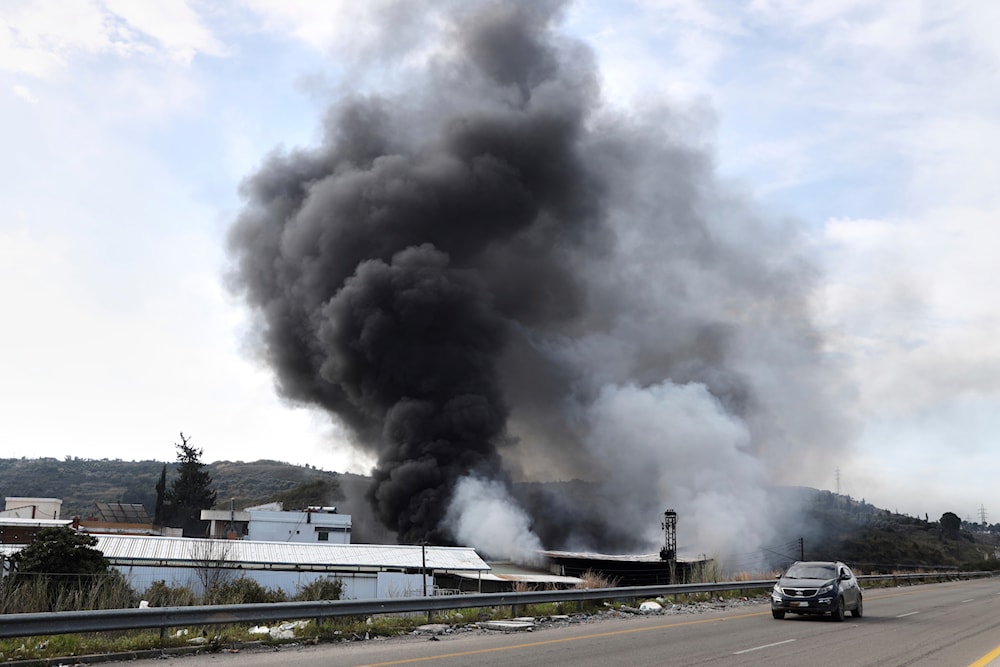Circulating footage shows civilians massacred in Latakia countryside
The violence has sparked protests among the Alawite community in Tartus and Latakia, with demonstrators gathering outside the Russian military base in Hmeimim.
-

Smoke rises from a factory hit during clashes in the outskirts of Latakia, Syria, Friday, March 7, 2025 (AP)
Al Mayadeen’s correspondent in Syria reported on Friday a series of massacres in coastal areas, citing local sources who stated that an armed group dressed in military and General Security uniforms stormed the village of al-Mukhtariyah. The attackers reportedly separated the men from the women and children before executing the males.
Our correspondent noted that similar atrocities took place in the town of al-Haffa and the village of al-Qabo, describing the day as “one of the bloodiest” in the Latakia countryside.
According to reports, more than 30 civilians from al-Mukhtariyah were massacred. At the same time, the Syrian Observatory for Human Rights estimated the total death toll of clashes between security forces and militants reportedly affiliated with the former regime at 70, excluding the victims of the massacres.
Leaked information from military operations authorities indicated that 45 of their fighters were killed, while 25 fighters from armed groups were also killed.
Protests and calls for Russian intervention
The violence has sparked protests among the Alawite community in Tartus and Latakia, with demonstrators gathering outside the Russian military base in Hmeimim. Protesters called for Russian intervention to protect the sect and urged Moscow to take the matter to the UN Security Council.
Al Mayadeen’s correspondent highlighted the growing sectarian mobilization, stating that tensions continue to escalate as clashes persist in rural areas of Latakia and Tartus between the Ministry of Defense, General Security, and armed groups. These confrontations have largely spared major urban centers.
Our correspondent added that while the cities of Tartus, Latakia, and Baniyas remain under the control of military operations authorities, some neighborhoods in Jableh and Qardaha remain outside government control.
Since early morning, dozens of military convoys have been deployed to the coastal region, only to fall into ambushes, further intensifying the conflict. Meanwhile, clashes spread to Homs on Thursday night, with targeted attacks on Alawite neighborhoods, including footage of direct strikes on residential homes.
Warnings against sectarian incitement
In response to the escalating violence, the Supreme Islamic Council for the Alawite Sect in Syria and the Diaspora issued a strongly worded statement condemning sectarian incitement and calls for mass killings, particularly following the circulation of chilling footage showing dozens of blood-soaked victims lying on the ground.
مشاهد لمجازر بحق المدنيين في ريف #اللاذقية.#الميادين pic.twitter.com/sUyYWZQbaz
— قناة الميادين (@AlMayadeenNews) March 7, 2025
The council urged the UN Security Council to intervene under Chapter VII to protect the Alawite community and other minorities in the Syrian coastal region. According to Al Mayadeen’s correspondent, this statement marks the council’s most assertive stance to date, as it had previously worked to de-escalate tensions.
Urgent calls for dialogue and national unity
The Democratic Autonomous Administration of North and East Syria voiced its deep concern on Friday over the deteriorating situation in the coastal region, calling for immediate dialogue.
In a statement shared on social media, the administration warned that the ongoing clashes and rising tensions could push Syria to the brink of catastrophe, risking further massacres of civilians.
The administration urged all parties to exercise restraint, stressing that continued escalation would only deepen national divisions, with the Syrian people bearing the brunt of the conflict.
Commenting on the situation, the administration stated, “This escalation stems from Damascus authorities' failure to accurately assess Syria’s reality and their disregard for the sensitivities of its diverse social fabric.”
It emphasized that dialogue remains the only viable path toward a Syria that meets the aspirations of all its people, urging a “genuine national dialogue to foster stability and resolve deep-rooted disputes.”
Meanwhile, Syrian political parties and organizations issued a joint statement under the banner "Stand for Civil Peace and National Unity!" addressing the escalating violence.
The statement underscored that "Syrian blood is sacred and must not be spilled by fellow Syrians," calling for a rational, inclusive national discourse that transcends sectarian and religious divisions to thwart both internal and external adversaries.
The political forces categorically rejected any form of foreign intervention, including calls for "international protection," and condemned both overt and covert Israeli interference in the schism.
The statement argued that "purely security-based solutions have never been, and will never be, a viable resolution to national crises; instead, they only serve to deepen them." It called for a "comprehensive national dialogue involving all Syrians" and a political solution that includes the formation of a broadly representative national unity government as a stepping stone toward lasting stability.
The signatories stressed that the Syrian people have already endured immense suffering and bloodshed and must not be dragged into another devastating cycle of violence. Instead, they called for unity, reconciliation, and a collective national effort to rebuild and revive Syria.

 5 Min Read
5 Min Read








